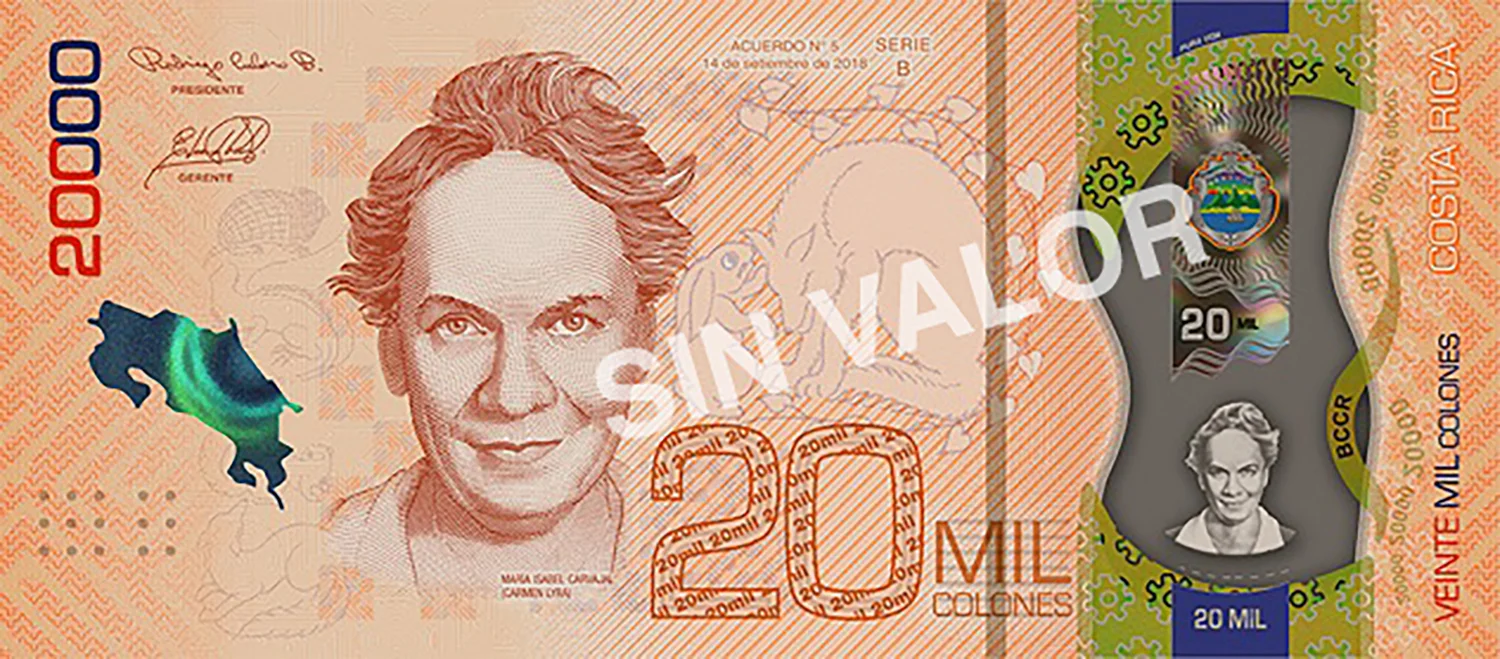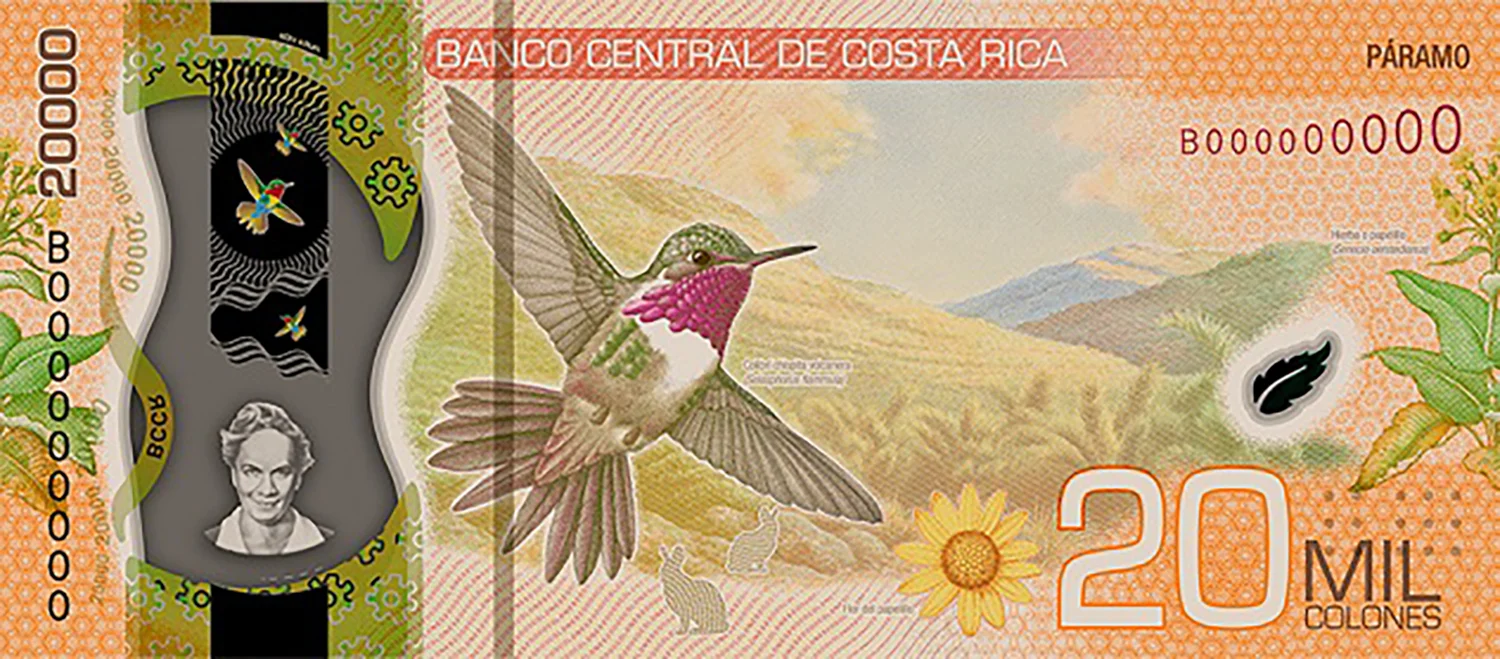
Currency manager: Central Bank of Costa Rica
New banknotes and coins combine environmental protection, aesthetics and security

No form of currency comes so weighted with symbolism and aesthetic consequence than cash. It needs to meet certain key requirements, some of which conflict: it has to be state of the art, to prevent counterfeiting, but also be familiar enough that no-one doubts it is genuine; it has to circulate freely, but its production and distribution must be carefully planned; and physical currency has to represent the authority that issues it, to its own citizens and the world.
The Central Bank of Costa Rica (BCCR) has stood out for meeting these conflicting requirements. It has produced a new set of polymer banknotes with commendable security and aesthetic qualities, while making a strong statement about the Central American country’s national identity as a progressive, environmentally conscious state. The progressive transition to these new notes for its population of five million also occurred during the global pandemic. Along the way, the new notes have attracted attention for their aesthetic qualities and their skill at representing Costa Rica – home to an extraordinary array of diverse wildlife – to the world.
The path to notable notes
The BCCR’s board of directors decided to establish a new set of polymer banknotes in 2017 and a new coin issue in 2020.
Juan José Leiva Cortes, head of cash control for the BCCR, and quality manager Adriana Chacón Soto tell Central Banking that the Costa Rican authorities decided to overhaul the country’s currency for several reasons.
One was commemorative – the bicentennial of the independence of most Central American states was approaching in 2021. Policy-makers also wanted to combat counterfeiting and upgrade the security features in Costa Rican money. Counterfeiters frequently targeted the existing paper notes, introduced between 2010 and 2012. The central bank received an average of 10,000 counterfeit cotton notes each year, Leiva says. From 2019, fake 500-colón coins also began to appear. Costa Rica already had some experience with polymer, having used the substrate for 1,000-colón notes from 2011. Marvin Alvarado, director of the department of issuance and securities at the central bank, said in a statement in November 2020 that at that time BCCR had not received a single fake 1,000-colón polymer note.
Environmental factors also played a role. Costa Rica is known globally as an ecotourism destination, but paper banknotes are neither easy nor cheap to recycle. In warm climates, paper also tends to wear out more quickly. Since polymer notes are more durable, they need to be replaced less often. Furthermore, they are lighter than their paper equivalents, easing transport (and, therefore, fuel consumption), according to BCCR officials.

The BCCR contracted with two European firms to print the polymer notes. Switzerland’s Orell Füssli produces the 1,000-colón and 10,000-colón notes (both released in October 2021), and France’s Oberthur Fiduciaire produces the 2,000-colón, 5,000-colón (both released in December 2020) and 20,000-colón notes (November 2020). The polymer itself is the Guardian substrate, manufactured by CCL Secure.
Each banknote contains a portrait of a significant figure from Costa Rican history on the obverse, chosen by the board of directors. The reverse features an image of one of the country’s many distinct ecosystems. The images of “flora, fauna and ecosystems” are “scientific drawings made by the Costa Rica Institute of Biodiversity”, Leiva says. For example, the 2,000-colón note, features Mauro Fernández, a 19th-century educational reformer and jurist. The reverse depicts a coral reef.
The notes include multiple security features. The portraits are raised above the rest of the note, as is the text giving the value of the note, alongside a set of raised dashes for the visually impaired. The notes also feature colour-changing holograms.

Costa Rica’s Judicial Investigation Department (OIJ) said it had discovered a production laboratory producing counterfeit copies of new polymer banknotes in January 2022. But its acting head of operations, Randall Zúñiga López, tells Central Banking that the lab, located in the provincial city of Pococí, was the only counterfeiting operation it had encountered in the past two years. Furthermore, the “quality of the false polymer banknotes was really very bad or crude”. Counterfeiters had sometimes managed to produce better, “although detectable”, fakes before, the OIJ official says.
Importantly, both the new banknotes and coins (the 500-colon was introduced in 2021) are fully recyclable, according to the BCCR. Previously, the coins were brass-plated, and it was very complex to separate the coins’ two layers for reuse.
Pandemic roll-out
The old cotton 20,000-colón and 50,000-colón notes ceased to be valid on February 1. The full transition from paper substrate to polymer is expected to conclude this year. The transition to the new notes was complicated because Costa Rican banks had to maintain two sets of cash-counting machines, as the series initially ran concurrently. Banks and other retailers also had to convert machinery, especially cash machines and vending machines, to accept polymer, Leiva and Chacón add.
Moreover, before the process had gone too far, the pandemic struck. As Costa Ricans’ movements became more restricted, the cash cycle slowed, which resulted in the need for new banknotes.
One factor that smoothed the transition was that the central bank preserved many key features of the old notes on the new substrate, the BCCR officials say. The new polymer notes were the same size and colour as their predecessors. Nonetheless, the BCCR still had to conduct a major public awareness campaign, including videos explaining the new security features and proper treatment of the polymer notes.
An aesthetic triumph
The Costa Rican polymer series has secured praise among the banknote community for the design and security of its new notes. In particular, the flora and fauna motifs are viewed as providing an excellent representation of Costa Rican identity. With its new notes and coins, the BCCR – a small central bank from a middle-income country – has become a leader in environmental sustainability, currency technology and the art of money.
The Central Banking Awards were written by Christopher Jeffery, Daniel Hinge, Dan Hardie, Victor Mendez-Barreira, Ben Margulies and Riley Steward
Only users who have a paid subscription or are part of a corporate subscription are able to print or copy content.
To access these options, along with all other subscription benefits, please contact info@centralbanking.com or view our subscription options here: subscriptions.centralbanking.com/subscribe
You are currently unable to print this content. Please contact info@centralbanking.com to find out more.
You are currently unable to copy this content. Please contact info@centralbanking.com to find out more.
Copyright Infopro Digital Limited. All rights reserved.
As outlined in our terms and conditions, https://www.infopro-digital.com/terms-and-conditions/subscriptions/ (point 2.4), printing is limited to a single copy.
If you would like to purchase additional rights please email info@centralbanking.com test test test
Copyright Infopro Digital Limited. All rights reserved.
You may share this content using our article tools. As outlined in our terms and conditions, https://www.infopro-digital.com/terms-and-conditions/subscriptions/ (clause 2.4), an Authorised User may only make one copy of the materials for their own personal use. You must also comply with the restrictions in clause 2.5.
If you would like to purchase additional rights please email info@centralbanking.com test test test




